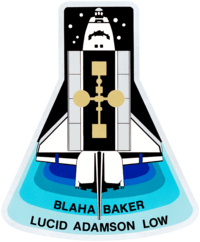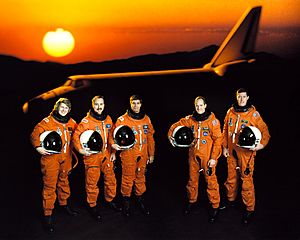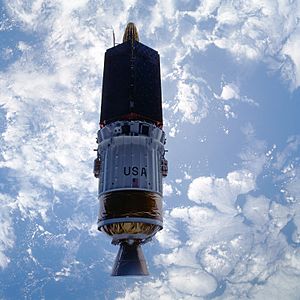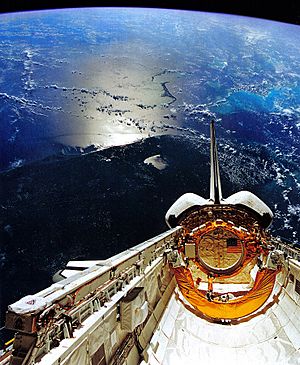STS-43 facts for kids

Atlantis deploying TDRS-E.
|
|
| Names | Space Transportation System-42 |
|---|---|
| Mission type | TDRS-E satellite deployment Technology |
| Operator | NASA |
| Mission duration | 8 days, 21 hours, 21 minutes, 25 seconds (achieved) |
| Distance travelled | 5,955,217 km (3,700,400 mi) |
| Orbits completed | 142 |
| Spacecraft properties | |
| Spacecraft | Space Shuttle Atlantis |
| Launch mass | 117,650 kg (259,370 lb) |
| Landing mass | 89,239 kg (196,738 lb) |
| Payload mass | 21,067 kg (46,445 lb) |
| Crew | |
| Crew size | 5 |
| Members |
|
| Start of mission | |
| Launch date | 2 August 1991, 15:01:59 UTC |
| Rocket | Space Shuttle Atlantis |
| Launch site | Kennedy Space Center, LC-39A |
| Contractor | Rockwell International |
| End of mission | |
| Landing date | 11 August 1991, 12:23:25 UTC |
| Landing site | Kennedy Space Center, SLF Runway 15 |
| Orbital parameters | |
| Reference system | Geocentric orbit |
| Regime | Low Earth orbit |
| Perigee | 301 km (187 mi) |
| Apogee | 306 km (190 mi) |
| Inclination | 28.46° |
| Period | 90.60 minutes |
 STS-43 mission patch  Shannon W. Lucid, James C. Adamson, John E. Blaha, G. David Low, Michael A. Baker |
|
STS-43 was the ninth space mission for the Space Shuttle Atlantis. This nine-day journey into space had a main goal: to launch a special satellite called TDRS-E. The mission also tested new technology for future space stations. Astronauts on board also did many science experiments. These experiments looked at how things behave in space.
Contents
Meet the Astronauts: The STS-43 Crew
The STS-43 mission had five brave astronauts. They were:
- Commander: John E. Blaha (his third space flight)
- Pilot: Michael A. Baker (his first space flight)
- Mission Specialist 1: Shannon W. Lucid (her third space flight)
- Mission Specialist 2: G. David Low (his second space flight)
- Mission Specialist 3: James C. Adamson (his second and last space flight)
Where Did They Sit?
Astronauts have special seats for launch and landing. Some seats are on the flight deck, like the cockpit of an airplane. Others are on the middeck, which is like a living area. The crew sometimes swapped seats between launch and landing.
Getting Ready for Launch
The launch of STS-43 happened on 2 August 1991. The Space Shuttle Atlantis lifted off from the Kennedy Space Center in Florida. The launch was planned for earlier dates. However, there were a few delays. These delays were due to small technical issues. For example, a part that helps separate the orbiter from its fuel tank needed replacing. Also, a main engine controller had a problem. Weather conditions also caused a delay. Finally, on August 2, Atlantis launched without any more problems. The shuttle weighed about 117,650 kilograms (259,370 pounds) at launch.
Mission Highlights: What They Did in Space
The main job of STS-43 was to launch the TDRS-E satellite. TDRS stands for Tracking and Data Relay Satellite. This satellite was released about six hours after launch. A special rocket stage, called the Inertial Upper Stage (IUS), then pushed the satellite into a very high orbit. This orbit is called geosynchronous orbit. It means the satellite stays above the same spot on Earth. TDRS-E became TDRS-5 once it was in space. It joined three other TDRS satellites already orbiting Earth.
The TDRS Network
The TDRS satellites are super important. They help spacecraft in low Earth orbit talk to ground stations on Earth. Before the TDRS network, spacecraft could only communicate when they were directly over a ground station. This was only about 15% of their orbit. With the TDRS network, spacecraft can talk to Earth almost all the time. This makes space missions much easier and safer.
Experiments in Space
The astronauts on STS-43 were very busy. They worked on many different experiments.
- SHARE II: This experiment tested a new cooling system. It was designed to transfer heat using a natural process. This technology could be used to cool future space stations.
- SSCE: The Solid Surface Combustion Experiment looked at how fire behaves in microgravity (weightlessness). This helps scientists understand fire safety in space.
- OCTW: The Optical Communications Through Windows experiment tested if fiber optic cables could send video and audio signals. This could be useful for connecting different parts of a space station.
- Other experiments studied how materials behave in space. They also looked at how the human body reacts to long space flights.
First Email from Space!
A cool moment during STS-43 was sending the first email from space! On August 9, 1991, astronauts Shannon Lucid and James Adamson sent an email. They used a Macintosh Portable computer and a system called AppleLink. The email was sent to a person at the Johnson Space Center. It said: "Hello Earth! Greetings from the STS-43 crew. This is the first AppleLink from space. Having a GREAT time, wish you were here, ... send cryo and RCS! Hasta la vista, baby, ... we'll be back!"
Landing
After a successful mission, Atlantis landed on 11 August 1991. It touched down on Runway 15 at the Kennedy Space Center in Florida. The landing was smooth and safe.
Mission Insignia
The STS-43 mission patch tells a story. It shows the Space Shuttle Atlantis rising from the shape of an old Project Mercury space capsule. This design highlights how the U.S. space program has grown over 30 years. The blue colors show the shuttle's powerful climb from Earth into space. In space, Atlantis' cargo bay is open. Inside, you can see the gold TDRS satellite. The stars on the patch are placed to show the mission number: four stars on the left and three on the right, making 43.
Wake-Up Calls from Space
NASA has a fun tradition of playing music to wake up astronauts. This started during the Project Gemini missions. The songs are often chosen by the astronauts' families. They usually have a special meaning to one of the crew members. Here are some of the songs played for the STS-43 crew:
| Day | Song | Artist/Composer | Played for |
|---|---|---|---|
| Day 2 | Back in the High Life | Steve Winwood | |
| Day 3 | Excerpts from "Dances with the Wolves" soundtrack | James Adamson | |
| Day 4 | Custom music medley sung by friends of the STS-43 crew from Rockwell-Downey, in California. |
||
| Day 5 | Music of the Clear Lake High School Orchestra playing selections from "Phantom of the Opera". Commander John Blaha's daughter, Caroline, plays in the orchestra. |
Andrew Lloyd Webber | John Blaha |
| Day 6 | What a Wonderful World | Louis Armstrong | |
| Day 7 | Cowboy in the Continental Suit | Chris LeDoux | James Adamson |
| Day 8 | Washington and Lee University fight song | G. David Low | |
| Day 9 | Sounds from Shannon Lucid's backyard |





